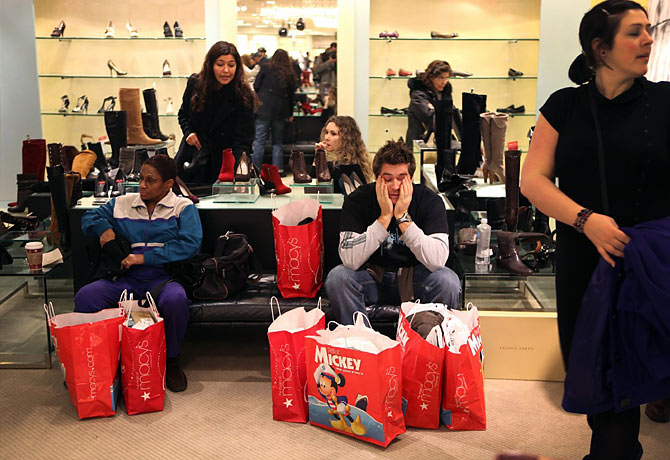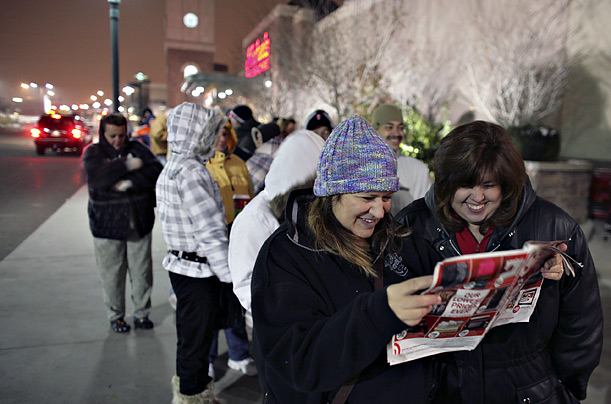Winners and Losers from Black Friday Weekend
 By Janet Morrissey, courtesy of TIME
By Janet Morrissey, courtesy of TIME
Electronics stores, toy retailers and certain teen-oriented apparel companies were big winners over the Black Friday holiday weekend, with door-crashing specials and price discounts attracting much of the traffic and sales, analysts say.
Best Buy, Walmart and Amazon were the shining stars as all three successfully used heavy marketing strategies and doorbuster prices, especially in electronics, to lure shoppers.
The losers were largely retailers who a) did not have big electronics offerings, b) did not offer huge Black Friday discounts or c) are not worshipped by teens. Count among them J. Crew, Chico’s and Banana Republic, which offered fewer discounts and saw traffic fall, says Goldman Sachs analyst Michelle Tan, in a note. Pacific Sunwear, Ann Taylor, Talbots and Gap stores were also weak, noted Credit Suisse analyst Paul Lejuez.
Electronics, far and away, was the lightning rod for bargain-hungry shoppers this year both in stores and online. Traffic at Best Buy was "materially bigger" and cash-register ring-ups exceeded last year’s sales, says Barclays Capital senior research analyst Michael Lasser.
Analysts cannot get a complete picture of Black Friday’s success until companies report fourth-quarter earnings early next year. But they closely monitored retailers on Black Friday weekend for shopper traffic and sales action. "The crowds were more significant than last year and they were moving products faster than last year," Lasser says.
 Best Buy’s doorbuster specials drew large Black Friday crowds with customer lines snaking around the block at many of its stores in the wee hours of the morning. Other retailers, such as Staples, Radio Shack, GameStop and hhgregg, also reaped benefits from the electronics frenzy, notes Credit Suisse analyst Gary Balter. Many offered sharp discounts on gadgets, ranging from laptops and high-definition TVs to GPS devices and e-readers, as they jockeyed to fill the void left by the demise of Circuit City in the past year. "There is an insatiable hunger for these devices and they make great gifts during the holidays," says Lasser.
Best Buy’s doorbuster specials drew large Black Friday crowds with customer lines snaking around the block at many of its stores in the wee hours of the morning. Other retailers, such as Staples, Radio Shack, GameStop and hhgregg, also reaped benefits from the electronics frenzy, notes Credit Suisse analyst Gary Balter. Many offered sharp discounts on gadgets, ranging from laptops and high-definition TVs to GPS devices and e-readers, as they jockeyed to fill the void left by the demise of Circuit City in the past year. "There is an insatiable hunger for these devices and they make great gifts during the holidays," says Lasser.
"The electronics stores all did really well — I think that everybody’s wish list this year has a flat-screen TV," says Rachel Weingarten, president of Octagon Strategy Group, a retail marketing consultant.
Walmart and Amazon were the wild cards, though, as both challenged electronics retailers on price every step of the way, allowing them to gain market share in the electronics sector. Walmart was especially competitive. "Walmart’s [average] prices were 3.5% below Amazon, 4.2% below Target and down double digits compared to both Kmart and Toys "R" Us," said Goldman Sachs analyst Adrianne Shapira, in a note. "Walmart left no doubt as to who was the pricing leader."
One who beat the odds: Macy’s, which "did really well this year and without crazy steep discounts," notes Weingarten.
Teen-oriented and casual-wear retailers, which had a slow start in November, were among the busiest over the Black Friday weekend. Companies such as Aeropostale, American Eagle Outfitters and Old Navy were big winners, wrote Credit Suisse analyst Lejuez in a research note. Traffic to Victoria’s Secret and Bath & Body Works was also strong, said Kimberly Greenberger, a managing director at Citigroup Global Markets.
But it was the cyberworld that scored the biggest gains this past holiday weekend. Online sales rose 35% on Black Friday and 14% on Cyber Monday from the same periods last year, according to Coremetrics, a Web-marketing firm. The average dollar amount per online order shot up 35% on Black Friday and 38% on Cyber Monday from a year earlier, the firm said.
Amazon scored a huge win from both the surge in cybershoppers and a spike in the number of shoppers cross-checking online prices before purchasing at a bricks-and-mortar store.
In a survey conducted by Nielsen, 59% of consumers indicated they planned to shop at least once at Amazon during the holiday season, says Ken Cassar, a Nielsen analyst."
An anomaly in all of this was luxury-jewelry retailer Tiffany, whose traffic was up year-over-year, although many of its sales were on lower-end silver items, says Joseph Feldman, managing director and retail analyst at Telsey Advisory Group.
Higher-end department stores such as Saks, Nordstrom, and Neiman Marcus saw decent traffic even though they didn’t offer discounts that exceeded 70% as they did last year. "Inventories are much tighter and promotions much more reasonable, which should lead to good margins," says Balter.
Analysts caution that the winners on Black Friday will not necessarily be the champions on Dec. 31. Tom Stemberg, former CEO and founder of Staples, and now managing partner of the Highland Consumer Fund, sees no correlation between Black Friday sales and a retailer’s ultimate success or failure over the holiday season. "Black Friday sales are about as meaningful as Groundhog Day is to the weather forecast," says Stemberg. "What happens is every retailer blows his brains out with these door-crasher deals trying to generate traffic."
In theory, he says, doorbuster sales are designed to lure shoppers into a store, where they’ll buy other items. In reality though, "the guy who shows up at 4 o’clock in the morning to get your door-crashers is way too busy racing to another store that has a door-crasher that’s starting at 6 o’clock and they want to get in line," he says. "It’s nuts."
Read a brief history of Black Friday.
Read "Black Friday Sales Were Encouraging, Retailers Say.
Photos courtesy of TIME.


